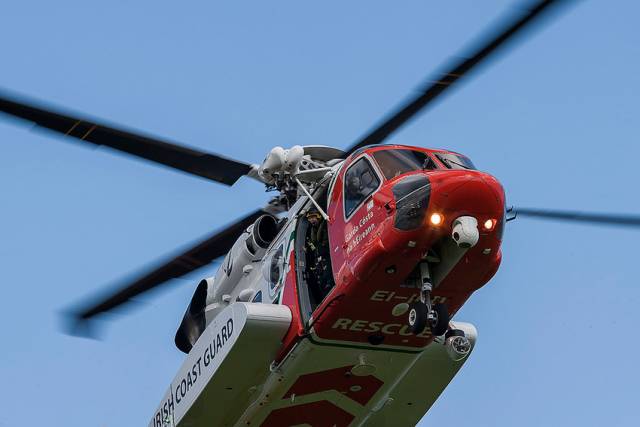#Rescue116 - The interim report from the investigation into the Rescue 116 tragedy has found that the Irish Coast Guard helicopter “pitched up rapidly” in its final seconds before crashing off Co Mayo a month ago.
Data recovered from the Sikorsky S-92’s ‘black box’ paints a terrifying picture of the seconds before the coastguard helicopter was lost at Black Rock in the early hours of Tuesday 14 March, with one of the crew calling for evasive action as the island loomed dead ahead.
Moreover, details in the Air Accident Investigation Unit’s (AAIU) preliminary report suggest the aircraft was flying using a pre-programmed route that was missing specific data relating to Black Rock, a small island east of Blacksod on the Mullet Peninsula.
Recordings from the cockpit also reveal that neither the mission commander and pilot Capt Dara Fitzpatrick nor co-pilot Capt Mark Duffy, whose lives were lost in the incident, had recent familiarity with landing in the area.
The Dublin-based coastguard SAR helicopter had been dispatched late on Monday 13 March to provide top cover for an offshore medevac being attended by Sligo’s Rescue 118.
Contact was lost with Rescue 116 as it approached Blacksod for refuelling and a search began immediately, with wreckage soon spotted off the western end of Black Rock and Capt Fitzpatrick recovered from the water within hours of the crash, though she later died in hospital.
Capt Duffy’s remains were recovered from the cockpit on the sea bed more than a week later. The search continues for their crew mates, winch men Ciarán Smith and Paul Ormsby, though after a major sweep by more than 100 fishing vessels this last weekend, the operation is now being wound down.
Rescue 116’s dual flight data recorder and cockpit voice recorder was recovered from the sea bed on Friday 24 March. Examination of the hardware revealed water damage to its memory board, requiring delicate desoldering of its circuits to recover the data, a process that is ongoing at the AAIB laboratory in the UK.
Additional data recovered from the aircraft’s Health and Usage Monitoring System (HUMS) identified no diagnostic alerts regarding Rescue 116’s critical systems or components.
Position data from the HUMS card was used to generate a placemark for what appears to be the last recorded position of the aircraft, though in its final seconds it was “subjected to complicated flight dynamics and a progressive deterioration of structural and systems integrity”.
All available data adds up to the following picture of the situation inside Rescue 116 before its loss:
- The mission commander and pilot (Capt Dara Fitzpatrick) was seated right of the co-pilot (Capt Mark Duffy) in the cockpit.
- All crew communications were mission-focused with no outside distractions.
- The helicopter routed from Dublin towards Sligo, then adjusted heading based on fuel requirements to Blacksod Lighthouse before a planned routing to the SAR mission offshore.
- After a crew briefing prior to arrival at Blacksod, Capt Fitzpatrick remarked that it has been some time since she had landed at Blacksod; Capt Duffy later said he had also not been to the area recently.
- The cockpit voice recording contains no reference by the crew to the presence of a lighthouse or terrain at Black Rock.
- The recording also indicates that Capt Duffy was using the helicopter’s weather radar to identify terrain features.
- 26 seconds before impact, the radio altitude sensor gave an aural alert, which Capt Fitzpatrick explained as “just a small little island... that’s B L M O [referring to Black Rock] itself”. Data places the aircraft at this time near an outcrop of two rocks just over half a nautical mile west of Black Rock.
- 13 seconds before impact, one of the rear crew members identified an island “directly ahead of us now guys” and suggested the helicopter should “come right” by “20 degrees”.
- Data shows the heading change was made before the rear crewman added with urgency to “come right now come right COME RIGHT”. A second later, Capt Duffy said: “We’re gone.”
- Two seconds before initial impact, data shows the helicopter pitched nose up, then after impact climbed with large changes in pitch, roll and yaw.
The recorded data, while not definitive, indicates that the flight crew was using an operator-specific route guide — a review of which is now warranted, says the AAIU.
The report also includes a recommendation to review instructions for the use of locator beacons on the Mk 44 lifejackets used by the crew, two of whom remain missing four weeks after the incident.
The AAIU investigation continues, but the preliminary report is available in full as a PDF to download below.
Update 15 April 2017: This article was changed to correct a misattribution of the final quote by Capt Mark Duffy to his colleague Capt Dara Fitzpatrick. The original article also misstated the designation of the pilot (and mission commander) and co-pilot.































































